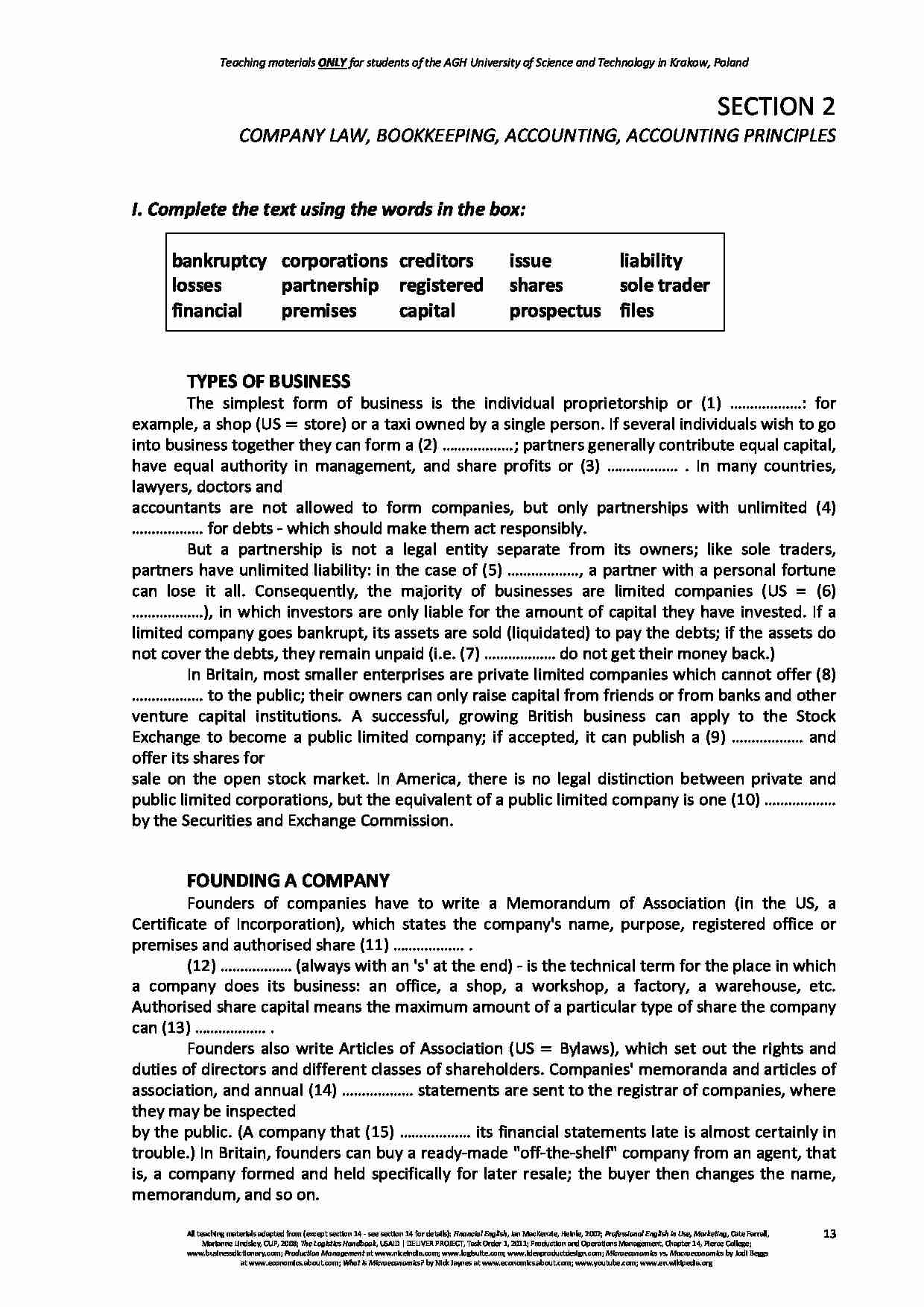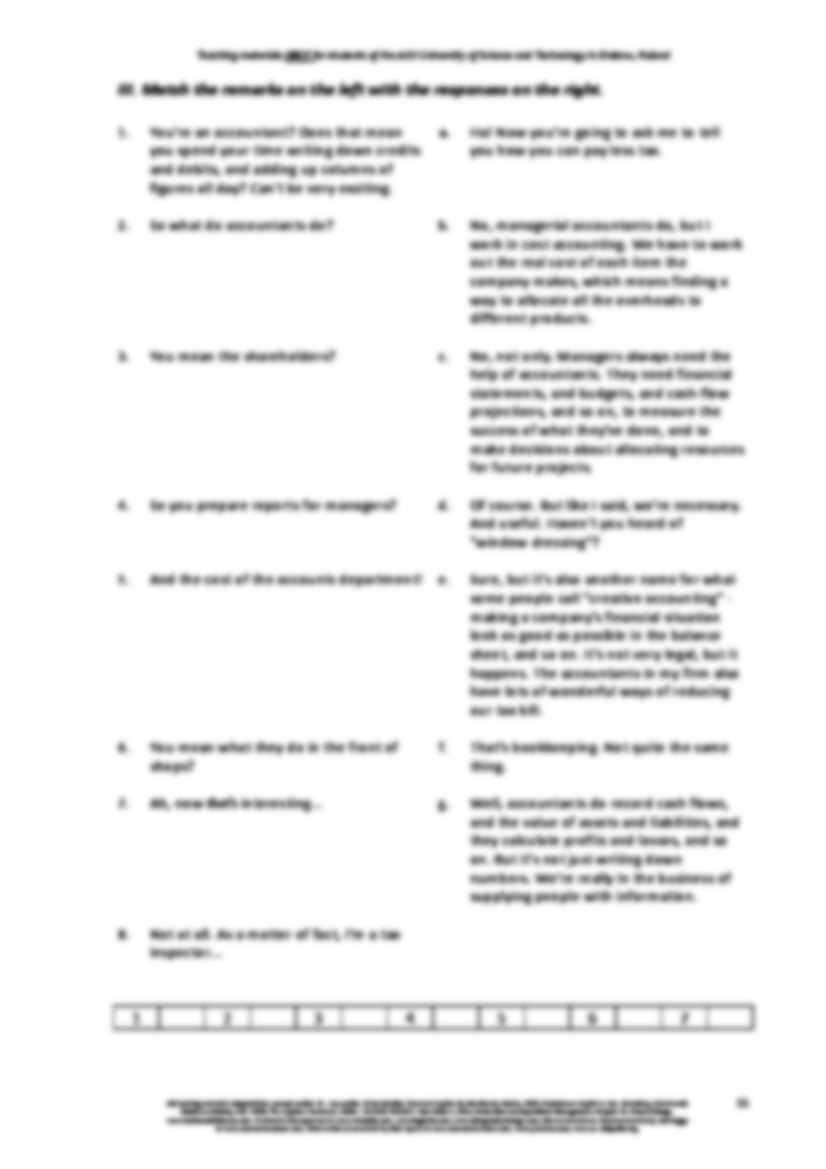Teaching materials ONLY for students of the AGH University of Science and Technology in Krakow, Poland All teaching materials adapted from (except section 14 - see section 14 for details): Financial English , Ian MacKenzie, Heinle, 2002; Professional English in Use, Marketing , Cate Farrall, Marianne Lindsley, CUP, 2008; The Logistics Handbook , USAID | DELIVER PROJECT, Task Order 1, 2011; Production and Operations Management, Chapter 14, Pierce College; www.businessdictionary.com; Production Management at www.niceindia.com; www.logisuite.com; www.ideaproductdesign.com; Microeconomics vs. Macroeconomics by Jodi Beggs at www.economics.about.com; What is Microeconomics? by Nick Jaynes at www.economics.about.com; www.youtube.com; www.en.wikipedia.org 13 SECTION 2 COMPANY LAW, BOOKKEEPING, ACCOUNTING, ACCOUNTING PRINCIPLES I. Complete the text using the words in the box: bankruptcy corporations creditors issue liability losses partnership registered shares sole trader financial premises capital prospectus files TYPES OF BUSINESS The simplest form of business is the individual proprietorship or (1) ………………: for example, a shop (US = store) or a taxi owned by a single person. If several individuals wish to go into business together they can form a (2) ………………; partners generally contribute equal capital, have equal authority in management, and share profits or (3) ……………… . In many countries, lawyers, doctors and accountants are not allowed to form companies, but only partnerships with unlimited (4) ……………… for debts - which should make them act responsibly. But a partnership is not a legal entity separate from its owners; like sole traders, partners have unlimited liability: in the case of (5) ………………, a partner with a personal fortune can lose it all. Consequently, the majority of businesses are limited companies (US = (6) ………………), in which investors are only liable for the amount of capital they have invested. If a limited company goes bankrupt, its assets are sold (liquidated) to pay the debts; if the assets do not cover the debts, they remain unpaid (i.e. (7) ……………… do not get their money back.) In Britain, most smaller enterprises are private limited companies which cannot offer (8)
(…)
… capital from friends or from banks and other
venture capital institutions. A successful, growing British business can apply to the Stock
Exchange to become a public limited company; if accepted, it can publish a (9) ……………… and
offer its shares for
sale on the open stock market. In America, there is no legal distinction between private and
public limited corporations, but the equivalent of a public limited company is one (10) ………………
by the Securities and Exchange Commission.
FOUNDING A COMPANY
Founders of companies have to write a Memorandum of Association (in the US, a
Certificate of Incorporation), which states the company's name, purpose, registered office or
premises and authorised share (11) ……………… .
(12) ……………… (always with an 's' at the end) - is the technical term for the place in which
a company does its business: an office, a shop, a workshop, a factory, a warehouse, etc.
Authorised share capital means the maximum amount of a particular type of share the company
can (13) ……………… .
Founders also write Articles of Association (US = Bylaws), which set out the rights and
duties of directors and different classes of shareholders. Companies' memoranda and articles of
association, and annual…
…?
2. What is business?
3. Who might possibly want to hear the story of your business and why? What sort of
‘language’ would you use to communicate your story to them?
4. How do you want to look in the eyes of these three groups of people?
18
All teaching materials adapted from (except section 14 - see section 14 for details): Financial English, Ian MacKenzie, Heinle, 2002; Professional English in Use…
... zobacz całą notatkę






Komentarze użytkowników (0)